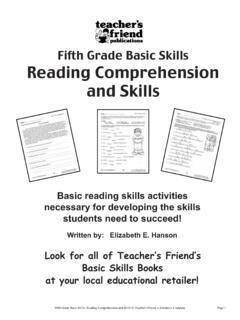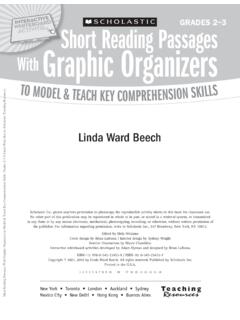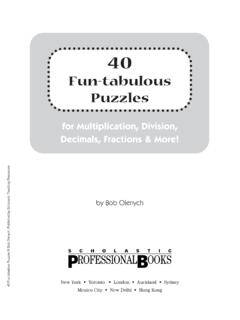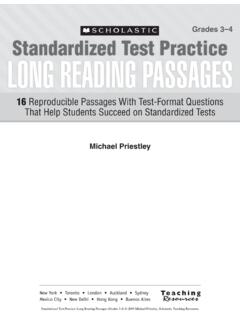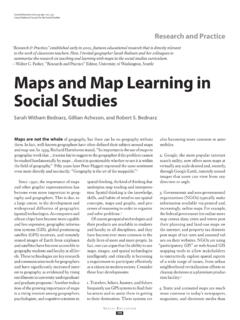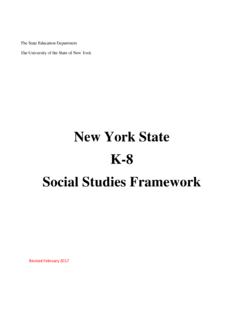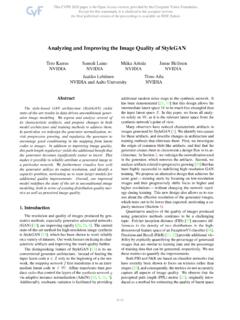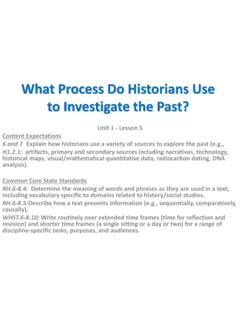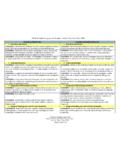Transcription of Analyzing Character Traits - Weebly
1 Analyzing Character Traits Engaging Lessons Aligned with Common Core Reading Standards Laura Candler 2012 Teaching Resources Common Core Aligned Literature Standards , , Teacher Information and Directions This mini pack includes a variety of strategies and printables for teaching students how to analyze Character Traits . You ll find a lesson on how authors reveal Character Traits , two Character trait lists, a variety of graphic organizers, several cooperative learning activities, and a list of suggested Character trait books. In addition, all of the Character maps are available in landscape format in a separate PDF file for use with an interactive whiteboard. These lessons are designed to take place intermittently over a period of several weeks or throughout an entire school year.
2 Why Teach Character Traits ? Character analysis offers an easy way to add rigor to any literature discussion. Character trait studies actively engage students and help them develop an understanding of characters motives. Studying Character Traits teaches students how to make appropriate inferences from facts. Furthermore, students deepen their understanding of literature by learning to support their opinions with details from the selection. Students enjoy debating and discussing Character Traits as their vocabularies develop. As a teacher, you ll enjoy the fact that these printables can be used repeatedly throughout the year simply by focusing on different characters and Traits . Common Core State Standards for Literature The lessons in Analyzing Character Traits are perfect for helping you teach Common Core Literature Standards in Grades 3 through 5.
3 The Character development component of each standard below can be taught using some or all of the materials in this packet. However, in order to teach all aspects of each standard, you ll need to find additional resources for the other topics described by that standard such as story settings and events. Grade 3 - 5 Standards That Reference Character Development Grade 3 RL Describe characters in a story ( , their Traits , motivations, or feelings) and explain how their actions contribute to the sequence of events. Grade 4 RL Describe in depth a Character , setting, or event in a story or drama, drawing on specific details in the text ( , a Character s thoughts, words, or actions). Grade 5 RL Compare and contrast two or more characters, settings, or events in a story or drama, drawing on specific details in the text ( , how characters interact).
4 Analyzing Character Traits Created by Laura Candler 2012 ~ Created by Laura Candler ~ Teaching Resources ~ Step-by-Step Lessons for Analyzing Character Traits 1. Advanced Preparation - Locate several short read-aloud books with memorable characters. You ll find a bibliography of suggested books on page 22. In addition, you can use short selections from a basal reading text. Biographies work well for Character trait lessons, but fictional characters can also provide a rich source of discussion. Duplicate a Character Trait list for each student. You ll find two versions on pages 6 and 7. You may want to duplicate the list on colored paper and laminate it since your students will be referring to this list frequently throughout the year. It s also helpful to locate individual dry erase boards and markers for each student.
5 Many of the lessons involve active participation, and dry erase boards are an easy way to involve all students. 2. Introduction to Character Traits - Begin by explaining the term Character trait. A simple definition might be the personal qualities that a Character demonstrates such as bravery or loyalty. Ask students to think of a Character from a recent book and name one Character trait that describes the person. Randomly call on students or have them write their responses on individual dry erase boards to show you. In general, physical qualities like height or hair color are not considered to be Character Traits . 3. Emotions versus Character Traits - Some students may be confused about the difference between emotions and Character Traits . Explain that the two terms are similar, but emotions can change from moment to moment, while Character Traits are developed over time.
6 For example, a Character may generally exhibit the trait of cheerfulness, yet he or she may feel the emotion of sadness when a friend moves away. 4. Distribute Character Trait List - Distribute one copy of the Character trait list to each student. Emphasize that they need to store this list in a safe place and take care of it because they will be using it repeatedly throughout the year. Ask them to read over the words, but don t stop to explain the meaning of each one. Later you ll be focusing on a new word each day as you discuss characters in stories and biographies. 5. Character Clues Overview - Now ask students how they think authors reveal a Character s personality to readers. Point out that authors seldom use Character trait words to describe characters; instead, they include clues throughout the selection.
7 Display the Character Clues overview on page 6 and discuss each type of clue with your students. As you discuss the difference between action clues, verbal clues, and other clues, ask them to cite examples from books or stories you have recently read. 2012 ~ Created by Laura Candler ~ Teaching Resources ~ 6. Character Trait Analysis - Immediately after introducing the Character Clues overview page, display the Character Clues graphic organizer on page 9 on a overhead projector or whiteboard. Read aloud a short book such as Tacky the Penguin and ask students to brainstorm a list of Character trait words that describe the main Character . If their Character Trait list is laminated, they can circle the words on that list. If not, they can write them on a dry erase board or add to a class list on an interactive whiteboard.
8 Then choose one Character trait and write it in the center of the graphic organizer. Read through the book another time, asking students to notice actions, words, and other clues that support this trait. Add their ideas to the class graphic organizer. Don t worry if you can t find a detail for every category. In this case, you might want to use the graphic organizer several times with different characters to reinforce the concept of Character clues. 7. Daily Character Trait - This lesson is designed to take place during 15-minute daily mini-lessons over a period of several weeks. During that time, your students will develop a Character reference chart. Distribute copies of the Character Trait Reference on page 10. and display a copy for the class. Each day read a short selection or refer to a Character in a chapter book.
9 Identify a Character trait that applies to the main Character , making sure it s one that your students might not already know, such as gullible or ambitious. Write the word in the first column and explain the meaning of the word. Have students help you write a definition for the second column. Then have students brainstorm clues from the selection that support this Character trait and record them in the Literary Examples column. Add one word a day to the chart until you ve introduced all of the challenging words on the Character trait list. 8. Character Trait Sorting - To check for understanding, place students in teams of three or four and give each team one copy of the Character Trait Sorting map on page 11 and a set of Character trait word cards. Use the cards on page 12 or create your own with the template on page 13.
10 Students cut the cards apart and stack them face down in the middle of the chart. One by one, they take turns flipping over a card, reading it aloud, and discussing it with the team. The team decides if the trait is generally thought of as a positive attribute or a negative attribute and the card is placed face up in the appropriate spot. If it s neither positive or negative, they place it in the Neutral box. If they don t know the meaning, they place it in the Unknown section. Students take turns flipping over and placing the cards so that everyone participates equally. Finally, discuss the team answers as a class. An alternate strategy would be to stop and have a team discussion after every word is placed on the sorting map. This will keep each discussion short and focused, preventing students from becoming bored during one long class discussion.

